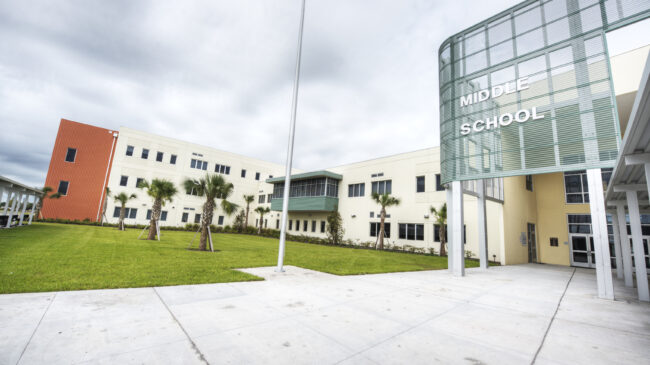Most of the 50.6 million K-12 students in the U.S. are assigned to their public schools. Students’ geographic residence inside their school districts often determines to which school they are assigned.
This means that many families’ public education options are limited by where they can afford to live, which leads to unequal education options for children because housing and schooling options have long been intertwined.
As the U.S. Senate Joint Economic Committee reported in 2019, “Despite public education’s promise of being a free, inclusive and equalizing force, families are faced with the reality that attending a high-performing public school often requires paying more for housing, and many students’ educational opportunities are limited as a result.”
Attendance zones and district boundaries place geographic limitations on the education options available to children that all too often reflect historic racial and socioeconomic divisions.
A straightforward policy reform — open enrollment — eliminates or weakens school attendance zones and district boundaries so families’ education options are not tethered to their geographic locations. With open enrollment, students can enroll in any district-run school so long as the schools have available capacity.
Open enrollment ends the monopolies districts maintain through residential assignment and forces district-run schools to compete with one another. In fact, a 2016 report by California’s Legislative Analyst’s Office showed that a robust education marketplace can have positive effects for students and school districts.
Of the 10,200 students participating during the 2014-15 school year “more than 90% of students (transferred) to districts with higher test scores than their home districts.”
At the same time, California school “home districts” (school districts that lost students) improved their instructional offerings and expanded efforts to engage with their communities to better compete with other school districts.
As school districts responded to market forces, many home districts experienced an increase in student test scores over time. California’s open enrollment program showed that competition between school districts can encourage improvements. Research indicates that increased competition from school choice options, such as charter schools or private school scholarships, can also incentivize district-run schools to improve.
Recognizing the advantages of a vibrant education marketplace, Florida’s public school choice program — Controlled Open Enrollment — is one of the most robust in the nation. In fact, nearly 10% of students enrolled in Florida’s district-run schools did not attend their assigned school in the 2018-19 school year.
Controlled open enrollment allows Florida children to enroll in any public district-run school with open seats since 2016. Not only does COE allow students to cross attendance zone boundaries inside the school district (intradistrict open enrollment), but students can also attend any school in another school district (interdistrict open enrollment).
Parents, however, of students participating in COE must often provide transportation to their children’s new schools.
All 67 school districts in the state are required to participate in COE and annually report the number of available seats to the Florida Department of Education. All COE policies must abide by a variety of requirements, including adhering to all federal desegregation requirements and permitting parents to declare school preferences including placement of siblings in the same school.
The state requires school districts to ensure preferential admission to transfer applicants who currently reside in the school district or who relocate due to foster care, a court-ordered change in custody due to a divorce, their active-duty military parent receiving a new station assignment.
If there are more COE applicants to a particular school than available seats, the district must implement a lottery to determine transfer student admission.
Florida, however, can make its COE program even better. Specifically, state policymakers should require the Florida Department of Education to publish data on transfer students. This change would ensure that schools don’t reject transfer applicants without good reason.
Nonetheless, Florida’s COE remains a prime example of how families exercise public education choice and should serve as a model to other states.
In the first three years of the program, more than 787,500 students participated in Florida’s COE. The fact that nearly 55% of COE students participated in the federal Free and Reduced-Price Lunch program during that time shows that COE gives low-income families access to education options outside their geographically assigned school.
Sarasota County Public Schools has participated in COE since the program’s beginning in 2016. By the 2018-19 academic year, the school district’s number of COE transfer students increased by nearly four times more than during the program’s first year there.
Almost half of COE students between 2016-17 and 2018-19 also participated in the Free and Reduced-Price Lunch program. During that time frame, most of Sarasota County Public Schools’ 8,977 transfer students were intradistrict transfers, with only 1.4% of transfer students living outside the school district.
During the 2018-19 school year, Sarasota County Public Schools accepted the most inter-district transfer students when compared to five other Florida school districts of similar size (Escambia, Lake, Marion, St. Lucie and St. Johns).
However, both Escambia County School District and St. Lucie Public Schools gained more intradistrict transfers that year than Sarasota County Public Schools. In fact, approximately 66% of students enrolled in St. Lucie Public Schools as intradistrict transfers during the 2018-19 academic year.
These enrollment patterns illustrate how families, especially those from low-income households, are willing to vote with their feet when unfettered from geographic attendance zones and district boundaries. K-12 open enrollment laws can break down the lingering effects of antiquated policies that intentionally divided communities based on wealth and race. Most importantly, they are student-centered, letting families make the education decisions that are best for their children, regardless of where they live.
A version of this column previously appeared in the Sarasota Observer.


